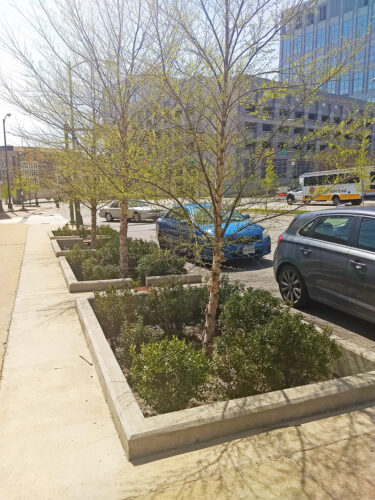
Urban Stormwater Systems
As development increases, so does the presence of impervious or water-resistant surfaces. Stormwater runoff is a factor that many cities and towns face. Trees help to offset this runoff by absorbing, redirecting, and slowing down water in our urban areas.
Historically, cities have considered trees as a landscaping value, not as a stormwater management asset. But with increased urbanization, many traditional grey or green stormwater management systems have become overburdened with the amount of water they are required to handle. Research has shown that adding trees to these systems is an inexpensive way to combat these issues.
Trees and Stormwater
In an effort to better understand how cities can utilize their urban forests as a vital tool for managing and reducing runoff, the Virginia Department of Forestry partnered with the Green Infrastructure Center (GIC) and the USDA Forest Service to complete case studies in Lynchburg, Harrisonburg, and Norfolk, Virginia. There is a case study booklet for each of these localities detailing the project, methodology, lessons learned and best practices for other cities who wish to do this work.
View these case studies and others completed for neighboring states at Green Infrastructure Center Stormwater Management Projects.
How Trees Reduce Urban Stormwater Runoff

Interception
Trunk, leaf, and branch surfaces intercept and absorb water, reducing the amount of water reaching the ground and reducing the volume of peak flows.
Infiltration
Growth of roots and organic decomposition loosens the soil, increasing soil infiltration rate and overall storage capacity.
Transpiration
Water is drawn up from the soil for the tree to use in photosynthesis. Eventually, the water is released as vapor from the canopy into the atmosphere.
Phytoremediation
In addition to taking up water, trees also uptake chemicals including fuels, solvents, and metals. Chemicals are either used as nutrients, stored, or transformed into less harmful substances. The more chemicals that are taken up by the tree, the cleaner the soil and better the water quality.
Erosion Control
Tree canopies reduce the velocity and volume of water that falls through the canopy. Slowing the speed at which this water hits the ground, allows time for surfaces to absorb the water, reducing the amount of runoff and erosion of bare soil. Tree roots also grab and hold onto soil particles keeping them in place even during large rain events.
With the proper site design and species selection, trees in urban areas can grow to their full size, live for decades, and provide continuous stormwater management services.
Free Mapping Software
Land Image Analyst
Land Image Analyst was developed by GDA Corp for the USDA Forest Service Chesapeake Bay Program as a land cover recognition tool to aid communities in developing land cover analysis and change detection. It has many applications, such as mapping tree canopy, identifying impervious surfaces, identifying stream buffers, and more.
Trees and Stormwater Calculator Tool
The Trees and Stormwater Calculator Tool is intended to simulate the impact of increasing or decreasing urban tree canopies upon stormwater runoff yield. The tool integrates average rainfall event data from local weather stations with high-resolution spatial (GIS) data representing land cover and soils to approximate the complex interactions of tree canopies, land surface cover, soils and storm events.
Policy and Practices Audit Tool
Policy and Practices Audit Tool evaluates urban codes, policies and practices to learn which practices or policies make the city more impervious or pervious. Requires collecting and scoring policies for a city to determine opportunities to increase infiltration and to utilize trees for stormwater management and other benefits.
Get guidance about using forest practices such as planting riparian forest buffers to help with stormwater management.
Additional Resources
- Learn more about mapping tools and other stormwater projects on the Green Infrastructure Center website.
- Learn more about Green Infrastructure in Virginia.
- Learn more about rain gardens as a stormwater management tool.
| Image | Title | ID | Description | Content Type | View | hf:tax:document-category | hf:tax:Media |
|---|---|---|---|---|---|---|---|
 | Rain Gardens | P00124 | Brochure educates landowners on options available to resolve issues with excess drainage from roofs, gutters, sidewalks, and roads, eliminating soil erosion, improving the quality of water, and how to put nature to work for you. Printed copies available. | Publication | View | urban-and-community-forestry water-quality | publication |
 | Rain Gardens: Technical Guide | P00127 | Technical guide provides detailed instruction for homeowners, teachers, community leaders, gardeners and landscape architects on the planning and development of rain gardens to create a landscape feature that will solve drainage problems, address erosion problems, improve water quality, create wildlife habitat and create a garden focal point. Printed copies available. | Publication | View | urban-and-community-forestry water-quality | publication |
| Stormwater to Street Trees | EPA publication explores engineering urban forests for stormwater management. | Publication | View | urban-and-community-forestry | publication |
Contact Us
For more information or questions, e-mail us or use our contact form.
